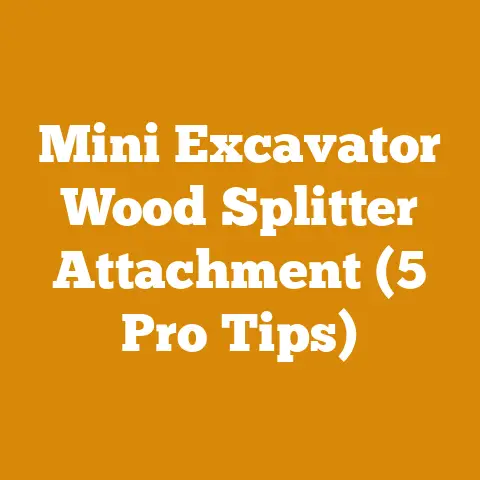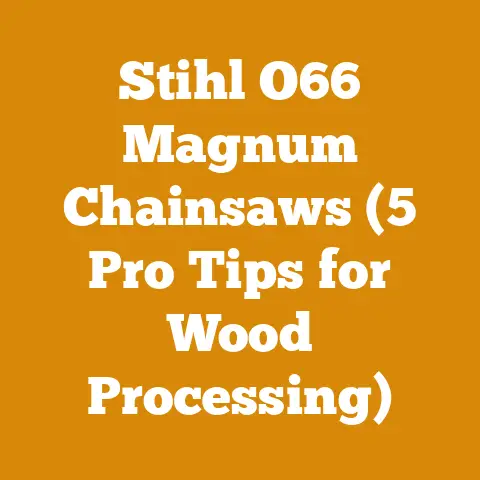How Do I Make an Owl Box (Barn Owl Habitat Build Tips)
Okay, here we go! I’m excited to share my knowledge and experience in building owl boxes, especially for barn owls. This is a project that combines my love for woodworking with my passion for wildlife conservation. Get ready for an in-depth guide packed with practical tips, data, and personal anecdotes.
How Do I Make an Owl Box (Barn Owl Habitat Build Tips)
Introduction: From Chainsaws to Owl Sanctuaries – My Journey into Woodworking and Wildlife
Key Takeaways:
- Understanding Barn Owl Needs: Learn the specific requirements of barn owls regarding nesting sites, including size, location, and safety features.
- Wood Selection and Preparation: Discover the best types of wood for owl boxes, how to properly treat them for weather resistance, and sustainable sourcing practices.
- Step-by-Step Construction Guide: Follow detailed instructions with diagrams to build a functional and durable owl box.
- Placement Strategies: Gain insights into selecting the optimal location for your owl box to maximize occupancy rates.
- Maintenance and Monitoring: Learn how to maintain your owl box and monitor its use without disturbing the birds.
Why Build an Owl Box? The Importance of Barn Owl Conservation
Before diving into the nuts and bolts of construction, let’s understand why providing a nesting site for barn owls is so important. Barn owls ( Tyto alba) are invaluable members of our ecosystems. They are highly efficient predators of rodents, consuming vast quantities of mice, voles, and rats. This makes them a natural form of pest control, reducing the need for harmful pesticides.
Data-Backed Benefits:
- Rodent Control: A single barn owl family can consume over 1,000 rodents per year. (Source: The Barn Owl Trust)
- Pesticide Reduction: Studies have shown that barn owl nesting programs can significantly reduce reliance on rodenticides in agricultural areas. (Source: University of California, Davis)
- Ecosystem Health: By controlling rodent populations, barn owls help maintain a healthy balance in the food chain.
Unfortunately, barn owl populations are declining in many areas due to habitat loss, pesticide use, and a shortage of suitable nesting sites. Natural cavities in trees are becoming increasingly scarce, and old barns are disappearing. Building an owl box is a simple yet effective way to provide these birds with a safe and secure place to raise their young.
Understanding Barn Owl Habitat Requirements
To build a successful owl box, it’s crucial to understand the specific needs of barn owls.
- Size Matters: Barn owls require a relatively large nesting cavity. A box that is too small will be unsuitable.
- Height Above Ground: The box should be mounted at least 10-12 feet above the ground to protect the owls from predators.
- Entrance Hole: The entrance hole should be large enough for the owls to enter easily but small enough to exclude larger predators.
- Darkness: Barn owls prefer dark, secluded nesting sites. The box should be designed to minimize light entry.
- Security: The box should be sturdy and well-constructed to withstand the elements and prevent collapse.
Choosing the Right Wood: Sustainability and Durability
Selecting the right wood is critical for the longevity and functionality of your owl box. I’ve learned this the hard way, having seen firsthand how quickly inferior materials can degrade in harsh weather.
Best Wood Options for Owl Boxes
- Exterior Grade Plywood: This is a durable and cost-effective option. Look for plywood that is rated for outdoor use and treated with a water-resistant sealant. I prefer using ¾ inch thickness for added strength.
- Data Point: Exterior grade plywood can last 10-15 years with proper sealing and maintenance.
- Cedar: Naturally rot-resistant and insect-repellent, cedar is an excellent choice. However, it can be more expensive than plywood.
- Data Point: Cedar contains natural oils that make it resistant to decay, extending the lifespan of the owl box.
- Pine: A readily available and affordable option, but it requires thorough treatment with a preservative to prevent rot and insect infestation.
- Caution: Pressure-treated lumber is not recommended, as the chemicals used in the treatment process can be harmful to owls.
Sustainable Sourcing Practices
As someone deeply connected to the logging and wood processing industry, I believe in responsible sourcing. Here are a few tips:
- Look for FSC Certification: The Forest Stewardship Council (FSC) certification ensures that the wood comes from responsibly managed forests.
- Support Local Sawmills: Buying wood from local sawmills can reduce transportation costs and support your community.
- Use Reclaimed Wood: Reclaimed wood from old barns or fences can be a sustainable and aesthetically pleasing option. Just be sure it hasn’t been treated with harmful chemicals.
Preparing the Wood
Once you’ve chosen your wood, proper preparation is essential.
- Cutting: Cut the wood according to the dimensions provided in the owl box plans (more on that below). Use a sharp saw for clean, accurate cuts.
- Sanding: Sand all edges and surfaces to remove splinters and create a smooth finish. This will make the box safer for the owls and easier to assemble.
- Sealing: Apply a non-toxic, water-resistant sealant to all surfaces of the wood, including the edges. This will protect the wood from moisture and prevent rot. I recommend using a sealant specifically designed for exterior use and that is bird-safe.
Step-by-Step Guide to Building Your Barn Owl Box
Now, let’s get to the fun part: building the owl box! I’ve refined this design over several iterations, incorporating feedback from local wildlife experts and observations of owl behavior.
Materials and Tools You’ll Need
- Exterior-grade plywood (¾ inch thickness) or cedar
- Non-toxic, water-resistant sealant
- Screws (exterior grade)
- Nails (galvanized)
- Wood glue (exterior grade)
- Saw (circular saw or hand saw)
- Drill with various drill bits
- Screwdriver
- Measuring tape
- Pencil
- Sandpaper
- Safety glasses
- Gloves
Owl Box Dimensions and Plans
Here are the dimensions for a standard barn owl box:
- Floor: 24″ x 24″
- Sides: 24″ high x 24″ wide
- Front: 24″ high x 26″ wide (includes a 2″ overhang)
- Back: 24″ high x 24″ wide
- Roof: 28″ wide x 30″ deep (includes overhangs)
- Entrance Hole: 6″ diameter (centered about 4″ below the top of the front panel)
Detailed Construction Steps:
- Cut the Wood: Using the dimensions above, cut all the pieces of wood. Double-check your measurements to ensure accuracy.
- Assemble the Box:
- Attach the sides to the floor using screws, nails, and wood glue. Ensure the corners are square.
- Attach the back to the sides and floor, again using screws, nails, and glue.
- Attach the front to the sides and floor. Remember to leave a 2″ overhang at the top.
- Cut the Entrance Hole: Using a hole saw or jigsaw, cut a 6″ diameter entrance hole in the center of the front panel, about 4″ below the top.
- Install the Roof:
- Attach the roof to the top of the box, ensuring it overhangs the front and sides by a few inches. This will help protect the box from rain.
- Use screws and glue to secure the roof in place.
- Add Drainage Holes: Drill several small drainage holes in the floor of the box to prevent water from accumulating.
- Seal the Box: Apply a final coat of sealant to all exterior surfaces of the box, paying particular attention to the seams and edges.
- Add a Perch (Optional): You can add a small perch below the entrance hole to make it easier for the owls to enter and exit. A simple dowel rod or small piece of wood will suffice.
Pro Tips for Construction
- Pre-Drill Holes: Always pre-drill holes before driving in screws to prevent the wood from splitting.
- Use a Square: Use a carpenter’s square to ensure that all corners are square. This will make the box more stable and durable.
- Apply Glue Generously: Don’t be shy with the wood glue. It will help create a strong, waterproof bond.
- Counter Sink Screws: Counter sink the screws so that the heads are flush with the surface of the wood. This will prevent the owls from getting scratched.
Placement is Key: Optimizing Your Owl Box Location
Building a great owl box is only half the battle. The location of the box is just as important in attracting barn owls. I’ve experimented with various placements on my property, and I’ve learned that certain factors significantly increase the chances of occupancy.
Ideal Habitat Characteristics
- Open Fields: Barn owls prefer to hunt in open fields with tall grasses, where rodents are abundant.
- Proximity to Water: A nearby source of water, such as a stream or pond, is beneficial.
- Limited Human Disturbance: Avoid placing the box in areas with high human activity or noise levels.
- Absence of Predators: Keep the box away from areas frequented by predators such as raccoons, opossums, and great horned owls.
Mounting Options
- Tree Mounting: If you have a suitable tree, you can mount the box directly to the trunk. Use sturdy brackets and straps to secure the box in place.
- Pole Mounting: A pole mount is a good option if you don’t have a suitable tree. Use a metal or wooden pole that is at least 12 feet tall.
- Building Mounting: You can also mount the box on the side of a barn or other building. Ensure the building is structurally sound and that the box is securely attached.
Height and Orientation
- Height: Mount the box at least 10-12 feet above the ground.
- Orientation: Face the entrance hole away from prevailing winds and rain. In most areas, an east or southeast-facing orientation is ideal.
Clearing Vegetation
Clear any vegetation that might obstruct the entrance hole. Barn owls need a clear flight path to enter and exit the box.
Maintenance and Monitoring: Respecting the Owls’ Space
Once your owl box is in place, it’s important to maintain it and monitor its use. However, it’s crucial to do so without disturbing the owls.
Annual Cleaning
- Timing: The best time to clean the owl box is in late summer or early fall, after the young owls have fledged.
- Procedure: Wear gloves and a dust mask. Remove all old nesting material from the box. Check for any signs of damage and repair as needed.
- Safety: Be careful when handling old nesting material, as it may contain parasites or pathogens.
Monitoring Occupancy
- Observation: Observe the box from a distance using binoculars. Look for signs of owl activity, such as owls entering or exiting the box, owl pellets (regurgitated bones and fur) beneath the box, or whitewash (owl droppings) on the front of the box.
- Avoid Disturbing: Never approach the box during the nesting season (typically March to August). Disturbing the owls can cause them to abandon their nest.
- Camera Installation (Optional): If you want to monitor the owls more closely, you can install a small camera inside the box. Choose a camera that is designed for low-light conditions and that will not disturb the owls.
Troubleshooting Common Problems
- No Occupancy: If the box is not occupied after a year or two, try moving it to a different location.
- Predator Problems: If you are having problems with predators, consider adding a predator guard to the entrance hole.
- Insect Infestation: If the box becomes infested with insects, try cleaning it more frequently. You can also use a non-toxic insecticide specifically designed for birdhouses.
Case Studies and Success Stories
I’ve seen firsthand the positive impact that owl boxes can have on local ecosystems. Here are a few inspiring examples:
- Agricultural Success: A vineyard in Napa Valley installed several owl boxes to control rodent populations. The vineyard reported a significant reduction in rodent damage and a decrease in the need for rodenticides.
- Community Project: A group of volunteers in Oregon built and installed owl boxes in a local park. The owl boxes quickly became occupied, and the park now boasts a thriving barn owl population.
- Personal Experience: On my own property, I’ve witnessed barn owls successfully raise multiple broods of young in the owl boxes I’ve built. It’s incredibly rewarding to know that I’m providing a safe haven for these magnificent birds.
The Future of Barn Owl Conservation: Our Role
Building owl boxes is just one small step in the larger effort to conserve barn owl populations. As responsible stewards of the environment, we can all play a role in protecting these valuable birds.
- Habitat Preservation: Support efforts to preserve and restore open fields and grasslands, which are essential hunting habitats for barn owls.
- Pesticide Reduction: Advocate for the reduction of pesticide use, particularly rodenticides, which can poison barn owls and other wildlife.
- Education and Outreach: Educate others about the importance of barn owl conservation and encourage them to build and install owl boxes.
- Citizen Science: Participate in citizen science projects that monitor barn owl populations and nesting success.
Actionable Steps: Getting Started Today
Ready to build your own barn owl box? Here are a few actionable steps you can take today:
- Research: Learn more about barn owls and their habitat requirements in your area.
- Plan: Choose a location for your owl box and develop a detailed construction plan.
- Gather Materials: Collect the necessary materials and tools.
- Build: Follow the step-by-step instructions in this guide to build your owl box.
- Install: Mount the owl box in a suitable location.
- Monitor: Observe the box from a distance and monitor its use.
Conclusion: A Rewarding Journey
Building an owl box is more than just a woodworking project; it’s an act of conservation. By providing a safe and secure nesting site for barn owls, you’re contributing to the health of your local ecosystem and helping to ensure the survival of these magnificent birds. I hope this guide has inspired you to embark on this rewarding journey. Happy building!






